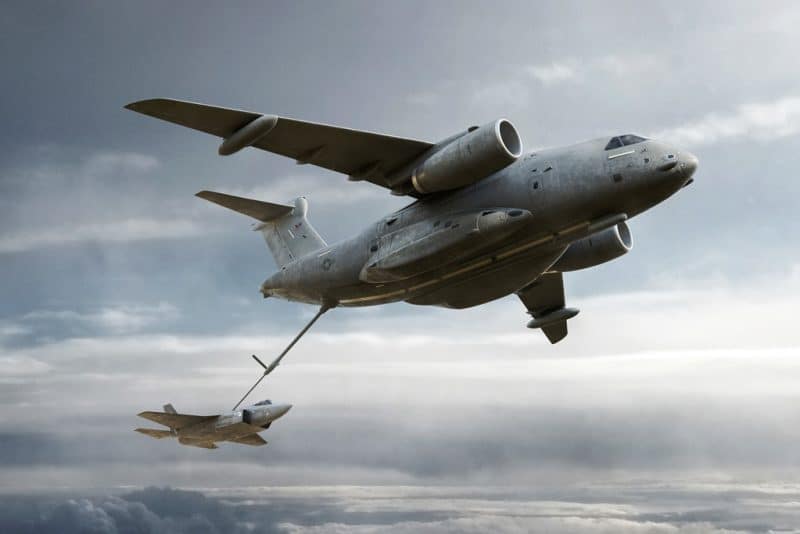Aviation
L3 Harris to Develop New Agile Tanker via KC-390 to Support Air Force
L3 Harris converting KC 390 into Agile Tanker for US Air Force Joint refueling Requirement.

Arlington, Va., September 19, 2022 — Embraer S.A. (NYSE: ERJ; B3: EMBR3) and L3Harris Technologies (NYSE: LHX) today announced a partnership to develop an “Agile Tanker,” a tactical aerial refueling option to address the U.S. Air Force’s operational imperatives and joint force refueling requirements, especially for contested logistics environments.
The companies signed an agreement to expand the capabilities of Embraer’s KC-390 Millennium tactical tanker aircraft. Enhancements include the addition of advanced boom operations and mission systems to support agile basing and sustainment for operations in contested areas, and resilient communications supporting JADC2 requirements.
“U.S. Air Force strategic planners have stated agile combat employment will require refueling platforms optimized to support a disaggregated approach to air dominance in contested logistics environments,” said Christopher E. Kubasik, Chair and Chief Executive Officer, L3Harris. “Collaborating with Embraer to develop and integrate new capabilities to the multi-mission KC-390 provides a cost-effective, fast-to-field solution that embodies our trusted disruptor approach.”
10 things about Embraer KC 390.(Opens in a new browser tab)
Aircraft enhancements will complement the tanker’s existing capabilities, which already include the ability to refuel aircraft with a variable speed drogue, receive fuel, and take off and land from short and improvised runways, allowing for greater mission area coverage.
Aircraft comparison Brazil’s KC-390 vs Japan’s Kawasaki C-2(Opens in a new browser tab)
“We continue seeking meaningful and strategic partnerships that generate new developments and expand the KC-390 Millennium’s market reach,” said Francisco Gomes Neto, President, and CEO of Embraer. “Our aircraft is capturing the attention of Air Forces around the world, and we’re thrilled by this opportunity to combine Embraer’s state-of-the-art platform and systems with L3Harris’ mission-driven solutions to deliver on the U.S. Air Force’s operational imperatives.”
The Air Force operational imperatives are a roadmap for successfully bringing about the new technologies, thinking, and cultures the Air and Space Forces must have to deter and, if necessary, defeat modern-day adversaries.
The speedy, versatile, customizable KC-390 Millennium can support a range of missions and possesses a high-reliability rate. By combining L3Harris’ experience as an aircraft missionization prime with Embraer’s state-of-the-art jet-powered KC-390 Millennium platform, both companies are ready to provide the next generation of tanker solutions for the Department of Defense and the US Air Force.
To support the Buy American Act requirements, the parties are studying the Agile Tanker program production with final assembly in the U.S., followed by aircraft modernization and missionization at the L3Harris’ Waco, Texas, aircraft modification center.

Aviation
COMAC Unveils Plans for the C929 to Rival Airbus and Boeing

After the success of China’s first C919 aircraft, the country is setting its sights on developing a larger plane. COMAC (Commercial Aircraft Corporation of China) has officially confirmed plans to build a widebody aircraft, marking a significant step in its aircraft lineup.
Traditionally, Airbus and Boeing dominate the widebody aircraft market, with decades of expertise in developing planes and engines capable of carrying heavy payloads. China, which currently relies on imported engines, is now aiming to challenge these giants with its own widebody jet, the C929, designed to compete with the Airbus A350 and Boeing 777.
American Airlines Is Looking for Flight Attendants: Apply Now
The C929 will be China’s first independently developed long-range widebody aircraft. It adheres to international airworthiness standards and boasts independent intellectual property rights. The baseline version is designed to seat 280 passengers and offers a range of 12,000 kilometers, catering to global demand for both regional and international air travel.
Russia, which also needs reliable narrowbody and widebody aircraft, could become a key customer for the C929. Additionally, China plans to target the broader Asian market as it continues to expand its aviation capabilities.
Close Call at Heathrow: BA Flight Narrowly Escapes Drone Collision
China’s aviation progress includes the ARJ21 (now called C909), a regional jet with 100 seats for shorter routes, and the C919, a narrowbody jet with 180 seats designed to rival the Boeing 737 MAX and Airbus A320. Both models have found increasing demand in the domestic market.
At China’s largest air show in Zhuhai, COMAC announced that Air China will be the launch customer for the C929 widebody jet, though details about order size and delivery timelines were not disclosed.
Other major deals announced by COMAC include:
- Hainan Airlines: Firm orders for 60 C919 and 40 C909 regional jets.
- Colorful Guizhou Airlines: 30 C909 jets, with 20 firm orders and 10 provisional agreements.
The C929, renamed from the CR929 after Russia withdrew from the joint development project in 2023, is expected to carry 280–400 passengers with a range of 12,000 kilometers, competing directly with Boeing’s 787 Dreamliner.
According to COMAC’s deputy general manager, Tong Yu, the first fuselage section of the C929 is expected by September 2027, with prototype test flights anticipated soon after.
-

 Aviation2 months ago
Aviation2 months agoMicrosoft Flight Simulator Raises $3 Million to Bring Back the An-225 Mriya
-

 Airlines2 months ago
Airlines2 months agoQantas Engineers Stage Walkout Over Cost of Living Concerns
-

 Airlines2 months ago
Airlines2 months agoQatar Citizens Can Travel to the United States Without a Visa
-

 Aviation2 months ago
Aviation2 months agoQatar Airways bans these new Electronic Devices on plane
-

 Airlines2 months ago
Airlines2 months agoJapan Airlines Rolls Out Free Domestic Flights to International Passengers
-

 Defence2 months ago
Defence2 months agoWhich Country Has the Largest Fleet of Fighter Aircraft?
-

 Airport2 months ago
Airport2 months agoWestern Sydney Airport Welcomes Its First Plane After 6 Years of construction
-

 Aviation2 months ago
Aviation2 months agoDid you know ? Once Boeing 747 carried 1088 passenger in 1991








